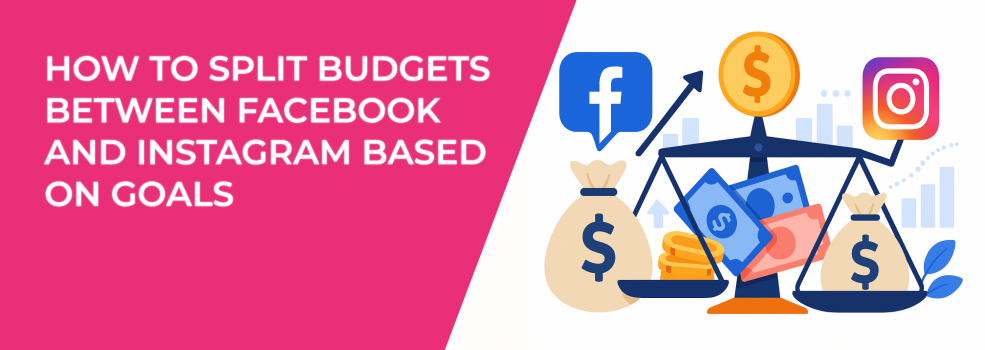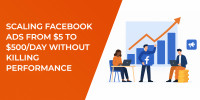If you're running ads on Facebook and Instagram, you've probably asked yourself:
How should I split my ad budget between the two platforms?
It’s a critical question. While both platforms are managed under Meta’s advertising umbrella, they each attract different types of users, support different formats, and shine at different stages of the customer journey.
In this guide, we’ll explore how to allocate ad spend based on your campaign goals, creative assets, and performance data. Whether you’re a small business owner or an experienced marketer, these insights will help you get more value from every dollar spent.
Why Proper Ad Budget Allocation Matters
Although Facebook and Instagram ads are managed in one place (Meta Ads Manager), they behave differently in practice.
Facebook gives you broad reach, deeper targeting options, and powerful retargeting tools. Instagram, on the other hand, excels at high engagement and strong visual appeal, especially among younger audiences.
Ignoring these differences can lead to underperforming campaigns or missed opportunities. Strategic budget allocation ensures your ads appear where they have the best chance of meeting your goals.
Understand the Strengths of Each Platform
To split your budget effectively, you need to understand what each platform does best.
Facebook is Ideal For:
-
Lead generation: Integrated lead forms, detailed targeting, and strong retargeting options.
-
Conversions: Custom audiences and event tracking help drive sales efficiently.
-
In-depth storytelling: Longer captions and video content are welcomed and effective.
-
Older demographics: Facebook’s user base tends to skew older than Instagram’s.
Instagram is Best Suited For:
-
Brand awareness: Eye-catching visuals perform well and generate high engagement.
-
Product discovery: Users often browse Instagram with a shopping mindset.
-
Short-form content: Reels and Stories drive quick attention and fast-paced engagement.
-
Younger audiences: Instagram users are typically under 35, often trend-focused.
Understanding these platform strengths is the foundation of a smart ad strategy. When you know which platform aligns with which goal, your budget decisions become more intentional and more effective. Instead of spreading your spend thin or relying on assumptions, you can double down where it matters most.
Align Budget Splits With Campaign Goals
To get the most out of each platform’s strengths, it’s crucial to match them with the correct Meta ad campaign objective from the start. Once you know what you want to achieve, your budget can be allocated accordingly.
1. Brand Awareness
If you're introducing a new product or trying to increase visibility, Instagram is often the better choice.
Why Instagram?
-
Its visually rich interface drives higher engagement.
-
Reels and Stories can get your brand in front of thousands with a relatively low cost-per-impression.
Suggested split:
-
60–70% to Instagram,
-
30–40% to Facebook.
Use your Facebook spend to support broader demographic reach and increase frequency among older users. Instagram should carry the visual storytelling and help spark initial interest.
2. Lead Generation
If you're focused on collecting emails, sign-ups, or quote requests, Facebook is typically more effective.
Why Facebook?
-
Built-in lead form ads simplify conversion with fewer steps.
-
Targeting tools allow for precision based on interests, behaviors, and lookalikes.
-
You can remarket effectively to warm audiences.
Suggested split:
-
70–80% to Facebook,
-
20–30% to Instagram.
Instagram can help drive awareness or soft engagement, but Facebook should be the core of your lead gen strategy. Be sure to create mobile-friendly forms and test different copy to lower your cost-per-lead.
If lead generation is a major priority this year, you’ll also want to explore these top tactics for Facebook lead generation in 2025.
3. Conversions and Online Sales
If you’re trying to drive e-commerce purchases or paid bookings, Facebook’s optimization tools are often more mature.
Why Facebook?
-
Dynamic product ads and advanced tracking help target high-intent users.
-
Conversion campaigns can be optimized for specific actions, like purchases or sign-ups.
-
Lookalike audiences from past customers can improve efficiency.
Suggested split:
-
60–75% to Facebook,
-
25–40% to Instagram.
Instagram still plays a critical role — especially with product-focused creatives — but Facebook often converts at a higher rate due to its user intent and algorithmic learning.
4. Customer Retention or Re-Engagement
Trying to re-engage lapsed customers or announce a new offer to your list? Facebook’s targeting options make it easier to reconnect with people who already know you.
Why Facebook?
-
You can upload email lists or retarget past website visitors.
-
Users are more likely to take action from detailed messaging or offers.
-
Event-based ads work well for time-sensitive promotions.
Suggested split:
-
65–75% to Facebook,
-
25–35% to Instagram.
Use Instagram for visual reinforcement. Post Stories that preview the offer or share testimonials, while letting Facebook handle the heavy lifting on clicks and conversions.
Don’t Forget About Your Creative Strategy
Budget allocation isn’t just about audience behavior — it’s also about the content you’re using.
Use Instagram when:
-
Your creative is highly visual (e.g., product photos, lifestyle videos).
-
You’re using short-form video content (especially Reels).
-
Your message is designed to be consumed quickly, with minimal copy.
Use Facebook when:
-
You’re providing more detailed product or service information.
-
You’re using formats like carousel ads, longer videos, or lead forms.
-
Your ad copy plays a key role in convincing users to take action.
Tip: audit your creative assets before you allocate budget. If your content is optimized for Stories and Reels, you might increase Instagram spend. If you're running long-form explainer videos or in-depth testimonials, Facebook deserves more focus.
If you’re unsure which ad types work best for your campaign, this guide to Facebook ad formats can help you align creative with campaign goals.
Use Automation Thoughtfully
Meta’s Advantage+ placements let the system automatically choose where your ads show — Facebook Feed, Instagram Stories, Reels, and more.
Pros:
-
Saves time during setup.
-
Optimizes for best-performing placements automatically.
-
Useful when you don’t have clear data yet.
Cons:
-
May prioritize low-cost clicks over quality leads or conversions.
-
Less control over where your brand is seen.
-
Doesn’t align well with tightly defined goals.
Strategy: start with Advantage+ when testing new campaigns, but review results after a few days. If Instagram placements are underperforming, shift more budget to Facebook manually, or vice versa.
If you're exploring automation through Meta’s Advantage+ system, make sure you're also following these best practices for scaling campaigns with Advantage+ budget allocation.
Review and Adjust Regularly
Your ideal Facebook–Instagram split won’t stay the same forever. Trends change, audiences shift, creative fatigue sets in.
Optimizing your budget split over time leads to significantly higher conversion rates compared to keeping it static.
Best practices:
-
Review performance every 2 to 4 weeks.
-
Use Meta’s platform breakdown to compare CPC, CTR, and ROAS.
-
Shift 10–15% of budget gradually based on what’s working.
If Instagram Reels are driving strong click-throughs, but Facebook Feed is where conversions are happening, consider using each platform differently: Instagram for top-of-funnel awareness, Facebook for bottom-of-funnel conversion.
Final Thoughts: Think Strategically, Not Just Tactically
Choosing how to split your ad budget between Facebook and Instagram is more than a logistical decision — it’s a strategic one.
Always consider:
-
Your core campaign goal.
-
Your audience’s behavior and demographics.
-
The format and style of your creative assets.
-
Performance insights from past campaigns.
Let your data guide your spend, and be ready to adapt. The platforms may change, but your approach to strategic planning can keep you ahead of the curve.

